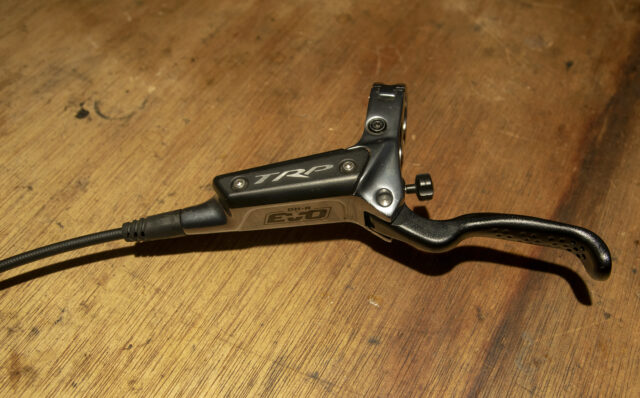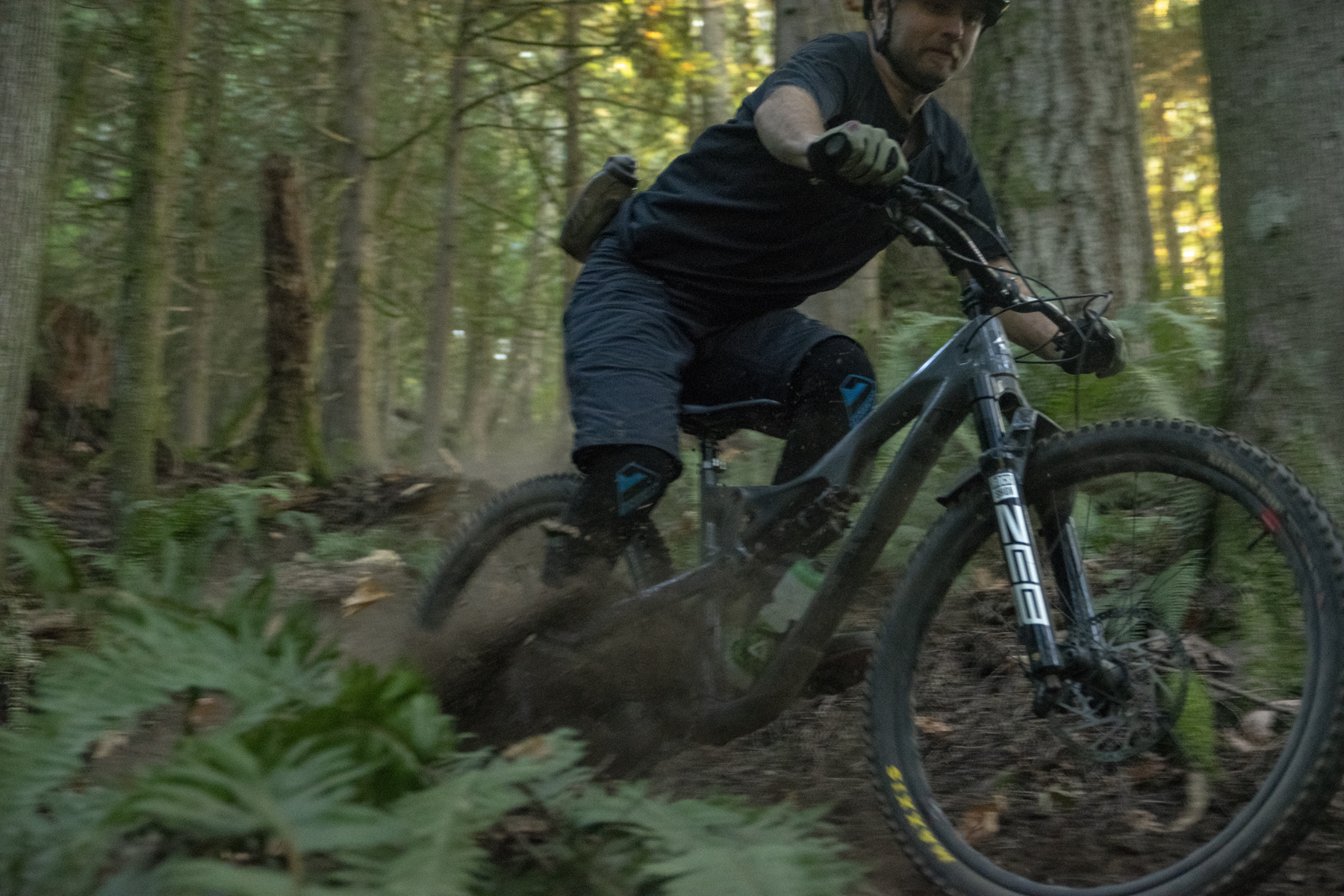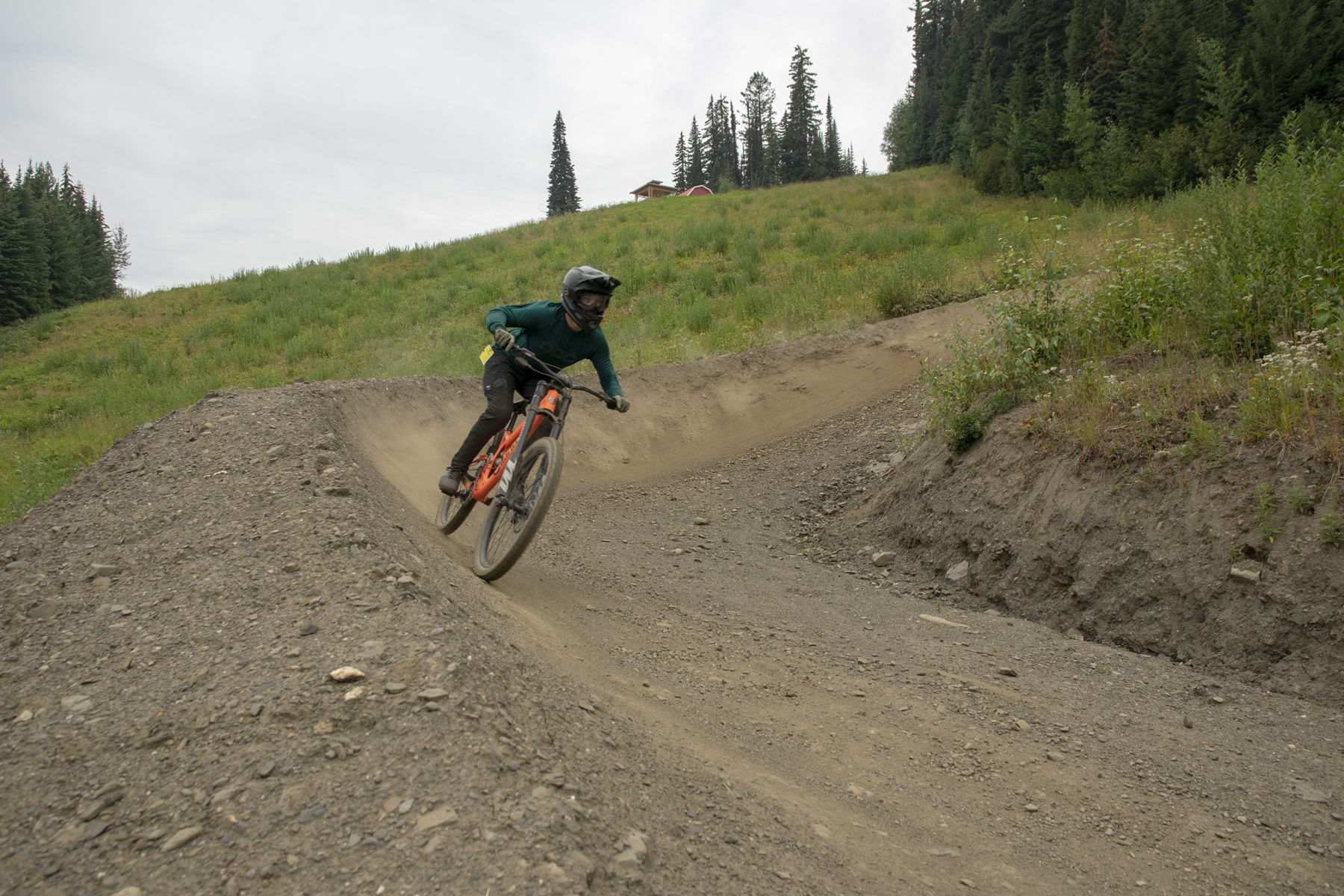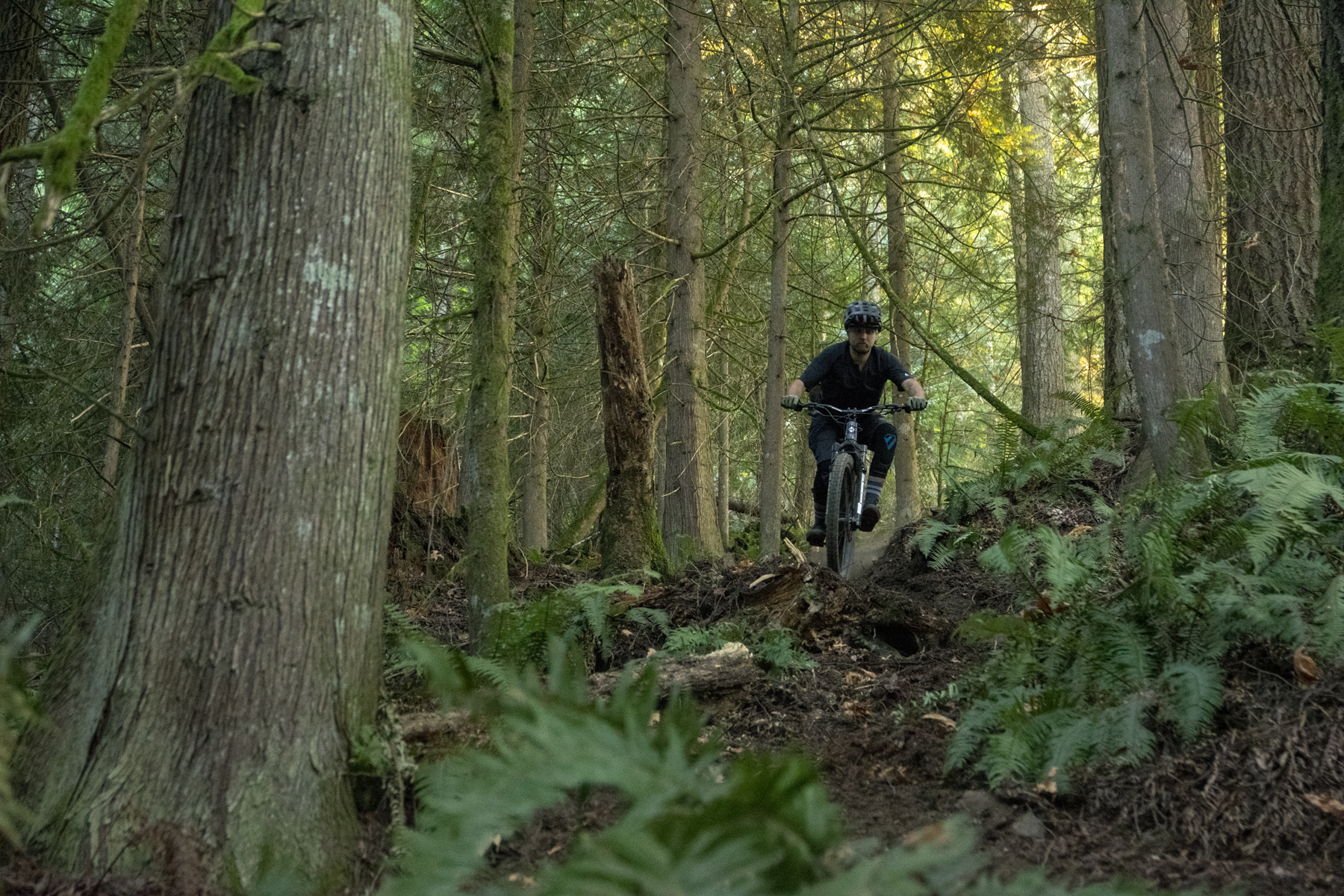TRP DH-R Evo Brakes
Blister’s Measured
Weight: 330 and 330 g (uncut hoses, no adapters or rotors)
MSRP: $270–300 per brake, w/o rotors or adapters (varies by color)
Bolted to: Antidote Carbonjack, Kavenz VHP 16, Canfield Jedi, Fezzari La Sal Peak
Reviewer: 6’, 175 lbs / 183 cm, 79.4 kg
Test Locations: Washington, British Columbia
Test Duration: 6 months

Intro
A few years ago, in our “Bike Industry Predictions for 2020–2029” episode of Bikes & Big Ideas, I called out brakes as one of the pieces of gear with the most room for improvement, as an entire category. Downhill and Enduro bikes are getting ridden harder and faster than ever before, and along with that, the rise of 29’’ wheels has meant that a given brake has effectively less power than it did on the smaller wheel sizes of old (in what is essentially the reverse of going to a larger rotor).
The industry has responded, with a whole bunch of new, much more powerful brakes cropping up, including TRP’s take on the genre: the DH-R Evo. Having now spent a whole lot of time on several pairs of them, the DH-R Evos are a compelling option for certain riders — but there are also tradeoffs that might steer other folks away. So who are they going to work best for, and how do they fit into the market as a whole? Let’s dive in:
Design
The TRP DH-R Evo shares a whole lot in common with the Trail Evo brakes that I reviewed a while back — and in fact, the two use the exact same caliper. As such, the DH-R Evo also uses mineral oil for the brake fluid and is designed around TRP’s 2.3mm-thick rotors, which are available in 180, 203, 220, and 223 mm diameters (6-bolt) and 160, 180, and 203 mm options (centerlock). The DH-R Evo calipers use four 16-mm pistons, constructed with a stainless steel outer sleeve for a harder-wearing, smoother sealing surface, with a resin insert in the middle to minimize heat transfer to the brake fluid. The DH-R Evo calipers use the same pad shape as Shimano’s 4-piston mountain bike brakes (in the non-finned versions); TRP supplies the brake with the same blue resin pad compound as the Trail Evo brakes, but offers full metallic pads as well, sold separately.
The pads are top loading for easy swaps and the caliper features a pivoting banjo bolt to route the hose at whichever angle is tidiest (which was especially useful on the Kavenz VHP 16, with its unusual rear brake mount that positions the caliper between the chainstay and seatstay). The DH-R Evo brakes come pre-bled but with the hose disconnected at the lever to simplify routing, particularly on bikes with internal routing. And to that end, TRP’s ingenious EZ-Plug system that I described in more detail in my review of the Slate T4 brakes carries over here as well. In short, the hose comes with a barb installed and a bolt threaded into the end of the barb to seal it off; this means that you can route the hose through any internal routing with it fully sealed (since the diameter of the barb matches the outer diameter of the hose) and then cut the hose to length to minimize fluid loss. The lever end comes sealed with a plastic bolt to help out with the same, and if you’re careful in your installation (doing it with the fitting end of the lever pointed up helps) you should be able to trim the hoses, bolt up the fittings, and go, without the need for a bleed.
The difference between the DH-R Evo and Trail Evo all lies at the lever end, but while the two lever bodies look a bit different cosmetically, the real functional distinction between the two is hidden internally: the diameter of the master cylinder piston. While the Trail Evo brakes use a 10 mm diameter piston, the DH-R Evo drops that down to 9 mm, which, perhaps counterintuitively, produces more power.
The smaller master cylinder piston means that the DH-R Evo has a longer free stroke than the Trail Evo (it takes more lever movement to displace enough fluid down the line to move the pistons to the rotor) but there’s correspondingly more mechanical advantage, so more force applied to the rotor for a given squeezing force at the lever. And voila — more power.

Despite their cosmetic differences, the DH-R Evo and Trail Evo levers feel nearly identical ergonomically — and indeed, they use the same lever blade, and position it identically relative to the bar, to the best of my ability to measure the two. The larger master cylinder diameter of the Trail Evo means that its free stroke is a little shorter and the bite point slightly firmer than that of the DH-R Evo, but the differences are more subtle than night and day.
The levers are asymmetric (i.e., right- and left-hand specific) but because the hoses come disconnected and full-length, setting up the DH-R Evos to your preferred configuration is straightforward. There’s a tool-free reach adjustment tucked in behind the lever blade, out of harm’s way, but no contact point adjustment to be found. I’m fine with that, for all the reasons that I laid out in my review of the Hayes Dominion A4 a while back, especially because the DH-R Evos have been very consistent in their bite point over the course of my time on them.
The levers use a hinged clamp so that they can be removed without messing with the other controls, and a variety of integrated clamp adapters are available if you want to tie your shifter and/or dropper lever into the brake clamp.
On the Trail
I’ve had generally positive experiences with a number of TRP brakes over the years, but have been left wanting for more power for use on bigger Enduro and DH bikes. The DH-R Evo, though, is very much up to the task. Shaving a single millimeter of the diameter of the master cylinder might not sound like much, but in the case of the Trail Evo vs. the DH-R Evo, it makes for a 23% increase in power (in theory). That sounds like a lot, but it’s absolutely borne out on trail — the DH-R Evos are much, much more powerful than their Trail counterparts.
That said, the DH-R Evos still aren’t the absolute most powerful brakes out there. The Hope Tech 4 V4, Hayes Dominion A4, and Cascade Components North Fork are all a notch stronger still; Shimano XTs feel pretty close, and the DH-R Evos are more powerful than SRAM Code RSCs, for example. We’ll go into more detail on that in our brake shootout article, coming very soon, but the DH-R Evos are indeed a proper DH brake, just not the outright most powerful.
What really sets the DH-R Evos apart, though, is their combination of very linear power delivery, moderate free stroke, and the fact that the bite point is still quite firm and direct once the brakes are fully engaged. It’s a tricky tightrope to walk since many of those traits are in direct conflict with each other — anything that increases power (i.e., leverage) will also make the free stroke longer and the bite point less firm; cams to alter the leverage curve to compensate tend to make the power delivery less linear and harder to modulate, and so on. Check out my chat with Hope engineer Sam Gibbs back in Ep.122 of Bikes & Big Ideas for a much deeper dive on those tradeoffs, but the balance that TRP has struck with the DH-R Evo is compelling, at least for the right riders.

That said, there’s one aspect of the DH-R Evo lever that didn’t work great for me — the reach. Now, granted, I like to run my brakes with the bite point set closer to the bar than average, but the DH-R Evo (and TRP Trail Evo) are the only modern brakes that I’ve tried to date that I can’t get the lever in as close as I’d like. The DH-R Evos are slightly better than the Trail Evos in that regard, simply because their free stroke is a little longer, but neither is ideal for my preferences. If you don’t like to run your brakes notably close to the bar, it’ll probably be fine — and I definitely think that a lot of people will fall into that camp. But if you’re like me and want to run them in very close, the DH-R Evos leave something to be desired. Dylan Wood, for example, was happy with the reach on the DH-R Evos — and lauded them as one of his favorite products of the year in our Gear of the Year episode of Bikes & Big Ideas — so this is a case where it’s important to know thyself and decide if you’re likely to care or not. Many folks won’t; I do.
And it’s too bad, because I quite like the DH-R Evos otherwise. The lever shape is really nice — kind of middle-of-the-road in terms of thickness, slightly chunkier than Shimano’s higher-end offerings but slimmer than the Hope Tech 4 V4 or Hayes Dominion A4 — with a well-shaped hook and some effective dimples for grip. Their raw power is good, they’ve been consistent and reliable in my time on them, and while this doesn’t tend to be my personal top priority, they really are especially easy to modulate for a brake that’s as strong as they are.
[I feel like “great modulation” often gets used as a euphemism for “not much power” but the DH-R Evos really are noteworthy for how well they combine the two.]

Rotors & Rotor Sizes
I’ve been increasingly sold on very powerful brakes and big rotors (within reason) for more gravity-oriented applications for reasons that I’ve discussed a bunch on Blister — the weight penalty for going beefier tends to be relatively modest, and in many circumstances, I find that a more powerful brake can actually be easier to modulate because you’ve got better motor control when you’re squeezing with more moderate effort, as opposed to hauling on the lever for all that you’re worth. And being able to use a lighter touch and not wring every ounce of power out of the brakes pays dividends when it comes to hand fatigue on longer descents, too.
Anyway, I tried a range of rotor sizes on the DH-R Evos over the course of my testing, from a 203 mm front / 180 mm rear combo all the way up to Galfer’s 246 mm monsters at both ends. That latter combo was indeed overkill, and my personal sweet spot was a 223 mm front / 203 mm rear package. That setup gave me more outright power than I strictly needed most of the time, but at a level where it was still easy to control, and where I didn’t have trouble getting enough heat into the brakes for them to work optimally, which was an issue at times with the 246 mm rotors.
And for that 223 mm / 203 mm package, I quite liked TRP’s own 2.3 mm thick rotors. The extra thickness does seem to help stave off overheating, and also seems to make them more resistant to warping and rubbing (especially in larger diameters) when compared to thinner options. There’s a modest weight penalty for the extra thickness (a 203 mm x 2.3 mm TRP rotor weighs 248 g, as compared to 196 g for the 1.8 mm thick version). That’s easily worth it for the sorts of bikes that you’d run the DH-R Evos on, in my opinion.

Maintenance
For the most part, the DH-R Evos have been easy to live with over the course of my testing. TRP offers a couple of different bleed kits that use different techniques — a Shimano-style funnel, a single syringe, and a dual-syringe system are all available. I found bleeding to be easiest when using a single syringe from the caliper end to push fluid up into the funnel at the lever end, but the various options all work just fine, and the DH-R Evos are generally easy to bleed. If I’ve got any quibbles with the process, it’s that it’s a little messy — no matter which of the tools I used, I found that I generally spilled a little mineral oil when disconnecting the syringe / funnel and closing the system. It’s not the end of the world, but mineral oil is a little harder to fully clean up than DOT fluid since it’s not water-soluble and I accidentally contaminated one pair of brake pads by not cleaning the caliper well enough after a bleed.
While it’s not strictly tied to the DH-R Evo brakes, I want to take a moment to shout out TRP’s hose-cutting and barb-installation tool that they sent over with the DH-R Evos. I gave it a more detailed writeup in our 2022 Holiday Gift Guide, so I won’t go into too much detail here, but in short, it makes the process of installing hose barbs (both in TRP brakes and those from other brands) so much easier than anything else I’ve tried to date. I’m a big fan.
Brake Pads
The blue organic pads that TRP supplies with the DH-R Evo brakes work quite well in dry conditions, and are both quieter and more effective when cold than TRP’s gold metallic versions; the metallic ones are more effective in wet conditions (once they’re up to temperature) and last a whole lot longer the resin ones. While I’ve been able to get the blue resin pads to fade a bit at very high temperatures on TRP’s less powerful brakes, the extra power of the DH-R Evos (and the added heat capacity of the 223 mm front / 203 mm rear rotor combination that I used for most of my testing) meant that I didn’t have the same issues on the DH-R Evos.
That said, I still prefer Galfer’s outstanding Pro pads to either of the stock TRP options. The Galfers are far more effective in the wet than TRP’s organic offerings, don’t need to be brought up to temperature to work well to nearly the same extent as the metallic ones, and have a touch more power than either. The TRP-branded pads aren’t bad by any stretch, but the Galfers are special.

Bottom Line
The TRP DH-R Evo brakes are a big step up in power as compared to TRP’s other offerings and are a compelling option for folks who want a powerful brake that has very linear power delivery and is especially easy to modulate for how powerful they are. The only major limitation is the reach to the brake lever — folks who prefer to run it in close to the bar are likely to be left wanting. But if you’d prefer to run the levers farther out, and especially if you find the very sharp bite of brakes like Shimano XTs to be too abrupt, the DH-R Evos are worth a look.

Great review! Very good to know about the long reach.
I own a set of DHRs as well and I prefer them to the other brakes I have tried. G2 RSC and 4 piston XT.
May try the Trail version my my short travel trail bike.
There’s a company that makes aftermarket levers to bring them closer to the bar. But they are pricey.
Good review. I freaking love these brakes. So consistent.
Amazing reviews – even after using these brakes for a year and with tons of research, I always learn something new from Blister reviews.
I’ve used many brakes ranging from Codes RSC, MT5, Zee, XTs (newest), and settled on DHR Evos. IMO, I feel like DHRs are the most powerful, but as you mentioned power, modulation and other traits conflict each other. Not expecting this from blister, but the ideal scientific brake comparison would be like the one from Enduro Mag except all utilizing same control rotor and pads (all from galfer) which will really test the brake itself since they play a massive part in all those traits.
Thanks, Jackson!
We’re actually working on exactly that — a big brake shootout, with all of the brakes tested with Galfer Pro pads and Wave rotors. Commenting on the stock options is important for the standalone reviews, but we’re going to do the most direct A/Bing that we can, too. That’s coming soon, stay tuned.
Hi,
question to tester :).
Are you able to compare DH-r Evo vs Dominon A4?
Mostly I am interreted in:
– consistent braking power without fading
– maximum power
– modulation
I am riding A4 od DH bike and it’s great, when the track is dry … on the wet I struggle, because (I assume) of little less modulation….
Does switching Hayes to TRP is worth it?
Freedom Coast Cycling (sister company to better bolts) solves the reach issue with their own cnc’d lever.
Yup, I actually reviewed those a little while back. They work nicely!